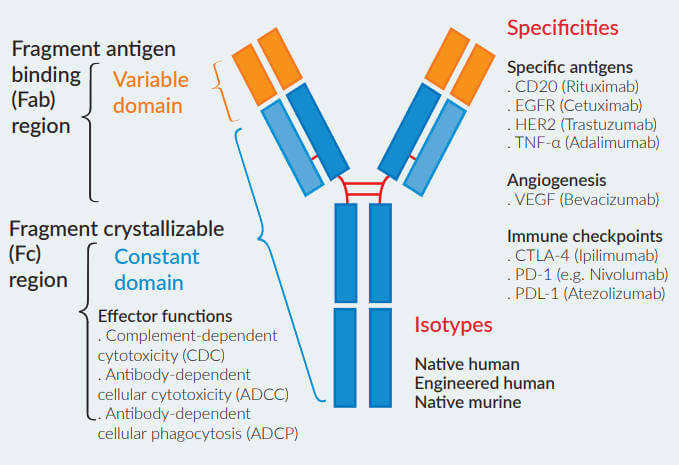Immunology 14 | General Structure of Antigen Receptors
1/26
Earn XP
Description and Tags
Helpful Videos: https://www.youtube.com/watch?v=wyzJDT0jJE8
Name | Mastery | Learn | Test | Matching | Spaced |
|---|
No study sessions yet.
27 Terms
Are B and T cells multimeric?
Yes.
BCR: Heavy/Light chains
TCR: has α/β or γ/δ
Multimeric refers to a protein or complex composed of multiple subunits or molecules that come together to form a larger, functional unit.

B and T cells have ______ regions that bind ______ with ______ specificity
B and T cells have variable regions that bind antigen with high specificity.
What is an ITAM?
An ITAM (Immunoreceptor Tyrosine-based Activation Motif) is a sequence of amino acids found in the cytoplasmic tails of certain immune cell receptors. When these receptors bind to their ligands, ITAMs get phosphorylated, triggering a signaling cascade that leads to cell activation. ITAMs are crucial in the activation of immune cells like T cells, B cells, and natural killer (NK) cells.
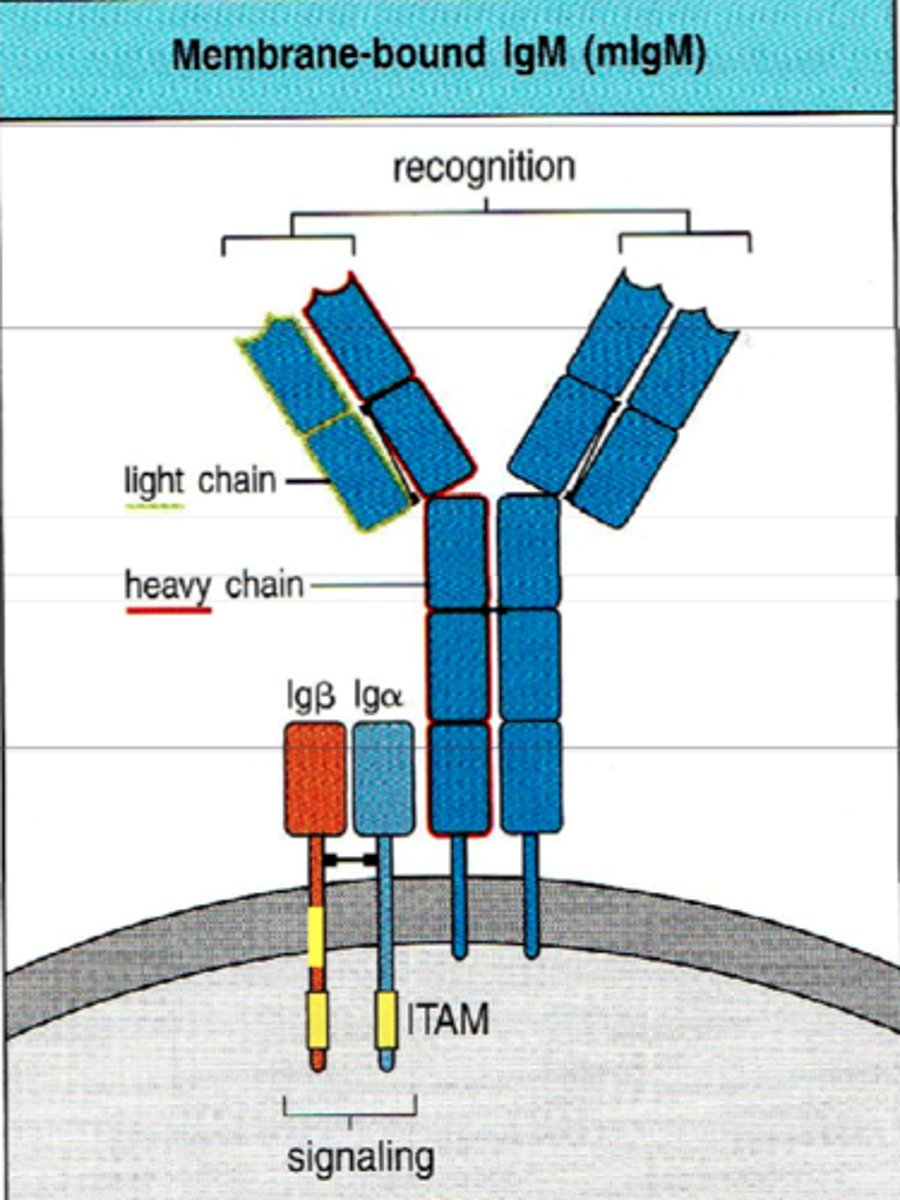
The variable region of each heavy and light chains ends with a set of 3 _____
Complementary determining regions that together form the antigen binding site.
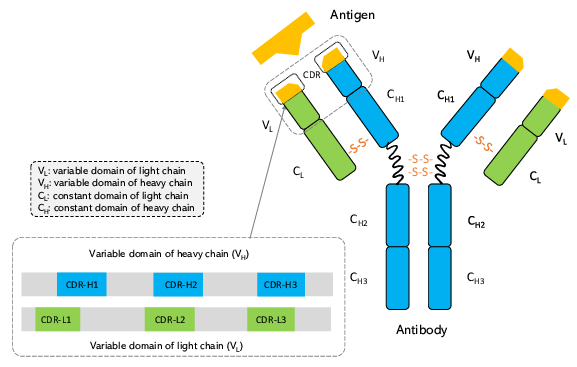
Recombination of gene segments is mediated by a complex of enzymes called...?
VDJ recombinase is responsible for rearranging different gene segments to create unique receptors on B cells and T cells. This process generates the diversity needed for the immune system to recognize a wide variety of antigens.
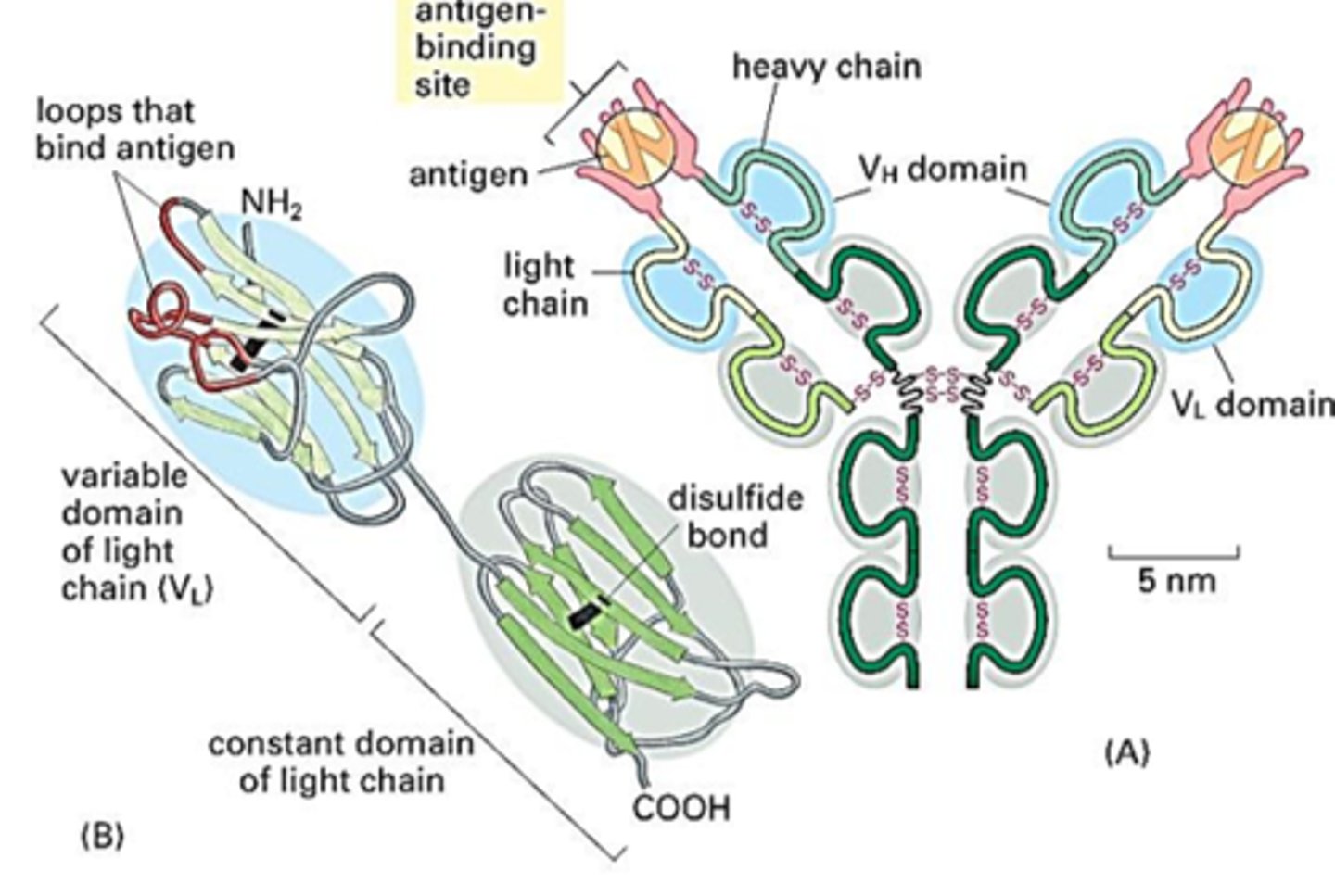
Which proteins are essential components of the VDJ Recombinase complex?
RAG Proteins (RAG-1 and RAG-2): Two specific proteins, known as RAG-1 and RAG-2 (Recombination-activating genes), are important for this recombination process. They help cut and join the DNA segments (V, D, and J segments) in the genes that encode B cell receptors (antibodies) and T cell receptors.
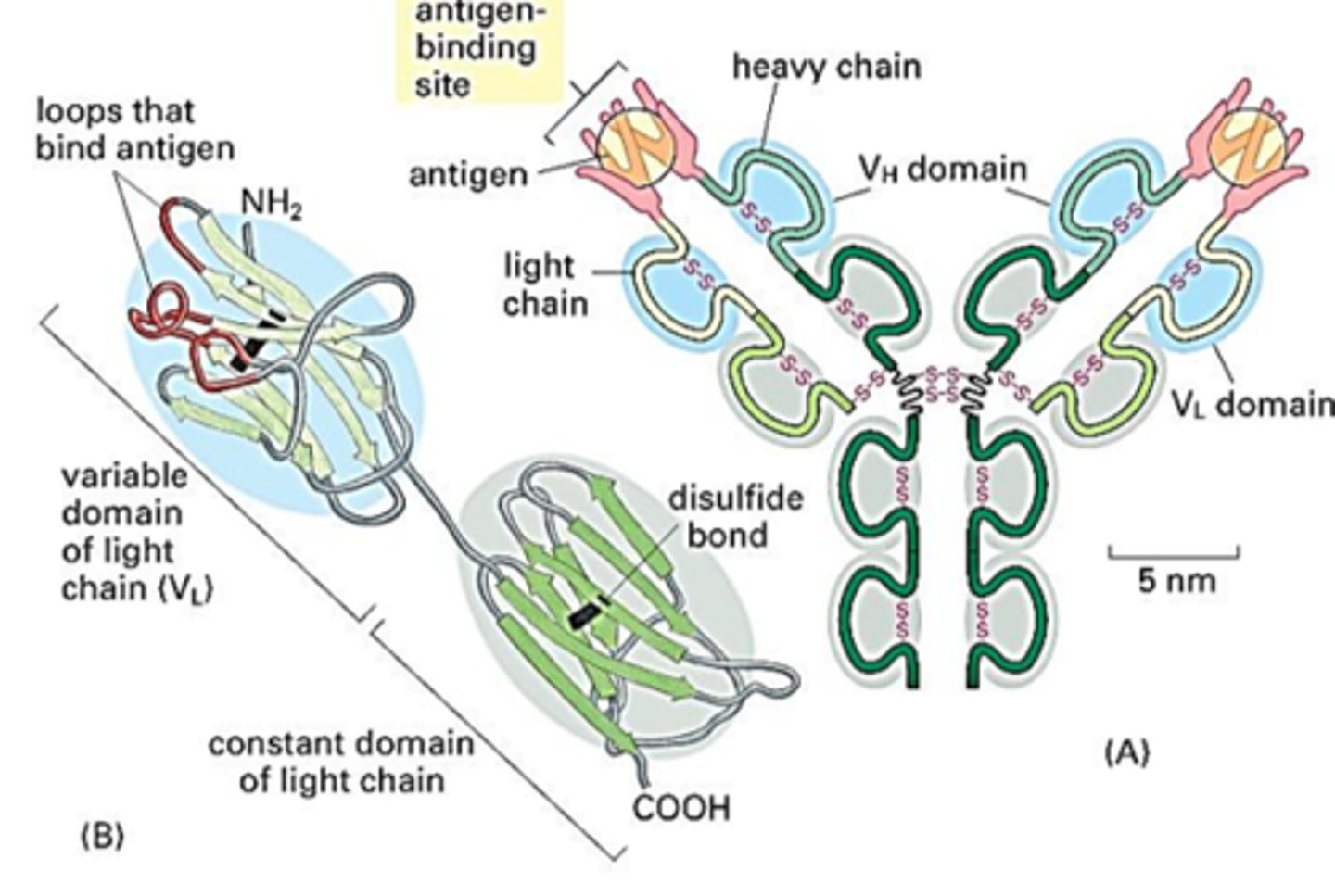
B cell receptors (Immunoglobulins) are composed of?
2 heavy chains and 2 light chains

T Cell Receptors are composed of?
α and β chains
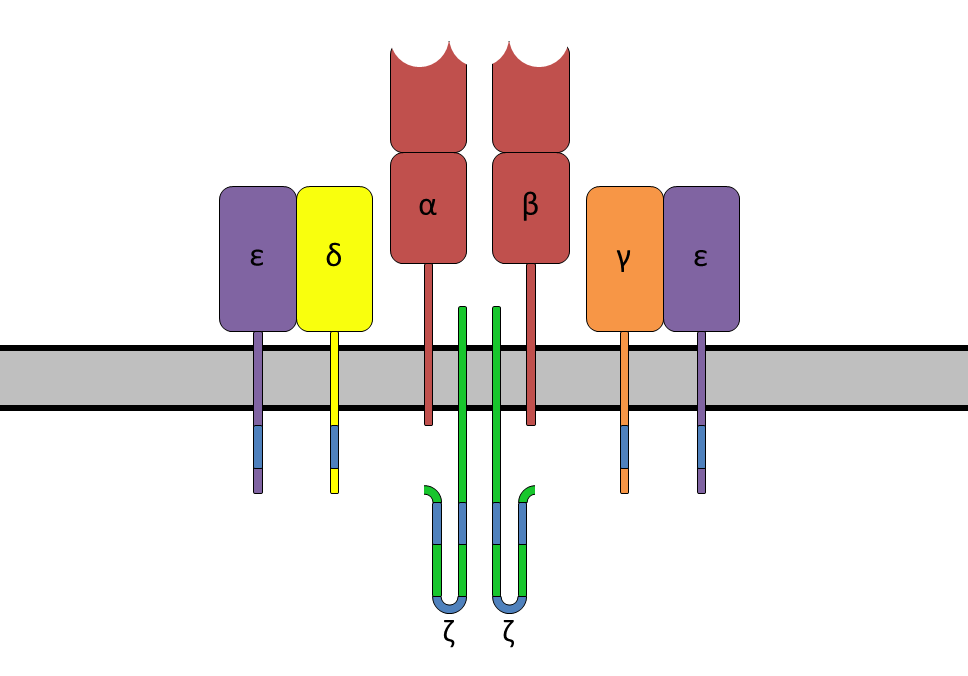
V, D, J segment selection is thought to be fixed or random? Is it irreversible?
Random and irreversible (extra-DNA excised out making it irreversible)

What is the step by step process of combinatorial genetic recombination for B Cells?
1. Signal Recognition: Recombination Signal Sequences (RSS) mark the boundaries of gene segments (V, D, and J) that need to be rearranged.
2. D-J Joining: In the germline DNA, D (diversity) and J (joining) segments are spliced together.
3. DJ-V Joining: The DJ complex is then joined with a V (variable) segment to form a complete VDJ segment.
4. Gene Transcription: The newly formed VDJ complex is transcribed into RNA, including the VDJ segment.
5. RNA Splicing: The VDJ RNA segment is spliced with a constant (C) region to create the full mRNA.
6. Translation: The mRNA is translated into a unique antigen receptor protein, which will be expressed on the surface of B cells or T cells.
*This process is similar for the B cell receptor light chain and T cell receptor α, β, γ, and δ chains. This recombination processes occurs first in the heavy chain and then light chain in B Cells.
Video
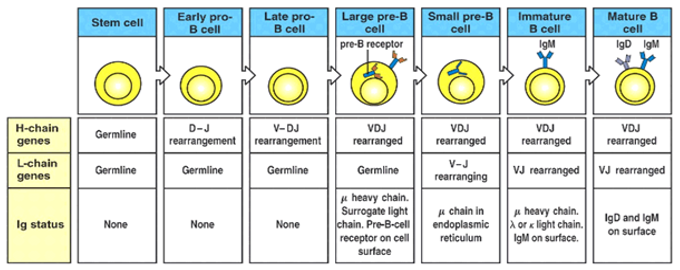
Where does B Cell genetic recombination occur?
In the bone marrow
What is it called where the constant regions on B Cells are replaced?
Isotype switching
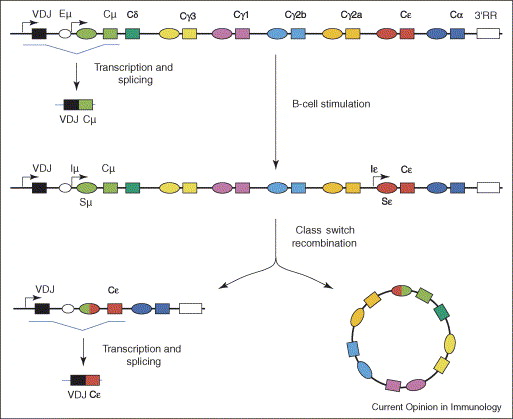
What is the difference between B Cell Receptor Rearrangement and Isotype switching?
BCR Rearrangement: This process involves the genetic recombination of V, D, and J gene segments to generate diverse antigen receptors on B cells during their development.
Isotype Switching: This occurs later in a B cell's life, where the antibody produced by the B cell changes its constant region (isotype) from IgM to other types like IgG, IgA, or IgE, while retaining the same antigen specificity.
BCR rearrangement creates diversity in antigen recognition, while isotype switching alters the antibody's constant region to change its function.
Explain the process of B cell isotype switching
1. Initial Expression: A mature B cell first expresses a B cell receptor with an IgM or IgD constant region.
2. Activation and Switching: When the B cell gets activated in the spleen or lymph nodes, specific cytokines trigger isotype switching.
3. DNA Splicing: During isotype switching, the DNA is spliced to replace the IgM or IgD constant region with a different constant region gene (IgG, IgA, or IgE), based on the cytokines present.
4. New Antibody Production: This results in a new antibody isotype (IgG, IgA, or IgE) while keeping the same antigen specificity.
5. Specialization: Different isotypes (IgM, IgG, IgA, IgE) have different functions and roles in the immune response.
Isotype switching changes the constant region of the antibody to adapt its function, while the antigen-binding part remains the same.
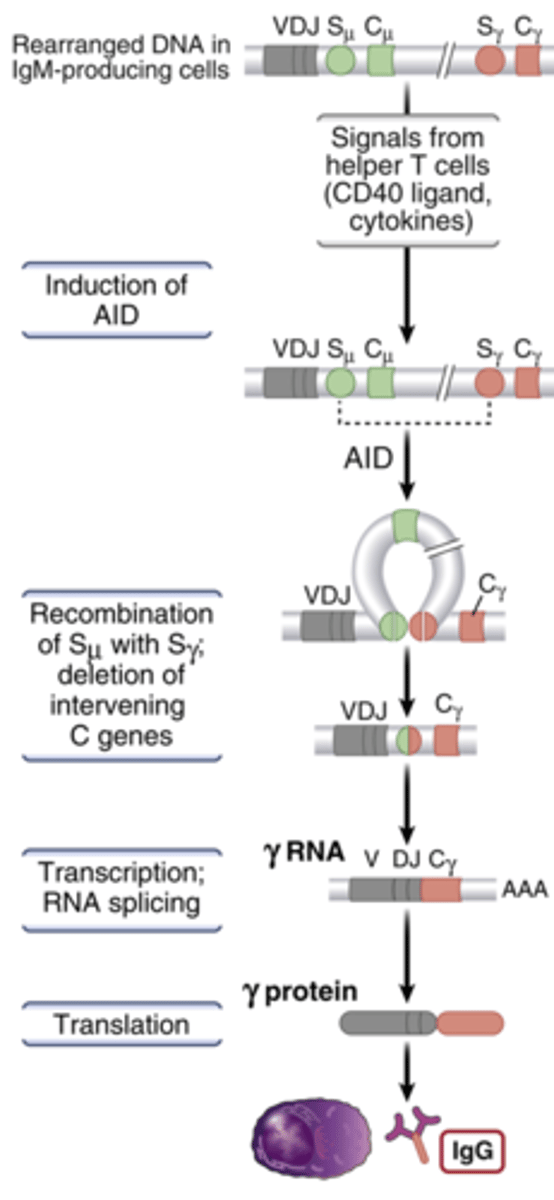
Isotype switching is triggered by which signals?
Cytokine signals
γδ T cells are composed of which chains and expresses which CDs?
TCR composed of γ and δ chains, express CD4 or CD8
NKT cells are composed of which chains and expresses which CDs?
Express αβ TCR, CD3, CD4, and receptors normally found on NK cells
What constant region do mature but naïve B cells use for their heavy chains before activation and isotype switching?
the μ constant (Cμ) region
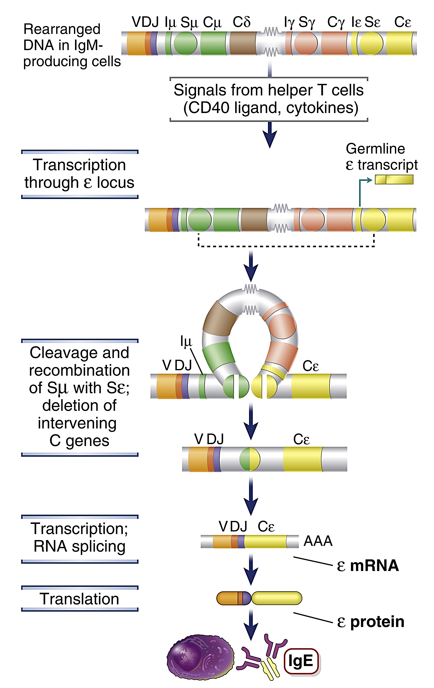
What is affinity maturation?
Affinity maturation is a process that improves B cells' ability to bind specific antigens. During this process, B cells mutate the variable region of their receptors, altering a few amino acids at a time. B cells with mutations that enhance antigen binding are selected for survival and continued proliferation. Conversely, B cells with mutations that reduce binding affinity are eliminated. This ensures that only B cells with the highest affinity receptors remain, refining the immune response.
What causes Severe Combine Immunodeficiency Syndrome (SCID)?
Severe Combined Immunodeficiency (SCID) can be caused by mutations in the RAG (Recombination Activating Gene) genes. RAG-1 and RAG-2 are crucial for the VDJ recombination process, which is necessary for generating functional B cell and T cell receptors. Mutations in these genes can impair this process, leading to a lack of functional B and T cells and causing SCID, a condition where the immune system is severely compromised.
What causes DiGeorge's Syndrome?
DiGeorge Syndrome is a genetic disorder where the development of the thymus gland is disrupted. This interruption in thymus development leads to impaired production of T cells, which are important for the immune system.
Why do B Cell Receptors have "multiple chances to make a functional light chain?"
B cells undergo several rounds of gene rearrangement to create a functional light chain for their receptors. This process provides B cells with multiple opportunities to produce a receptor that can effectively bind to antigens. After the initial VDJ recombination, which generates diverse antigen receptors, B cells engage in further processes known as isotype switching and affinity maturation.
Isotype switching allows B cells to change the constant region of their antibodies, tailoring their function for different roles in the immune response.
Affinity maturation involves fine-tuning the receptor's variable region through mutations, improving its ability to bind to specific antigens. Together, these processes ensure that B cells produce highly effective and specialized antibodies.
How do BCRs and TCRs differ in their ability to recognize antigens?
The B cell receptor can bind directly to a wide range of antigens, including proteins and polysaccharides, allowing it to target various types of pathogens and molecules.
T cell receptor cannot directly recognize antigens. Instead, TCRs require antigens to be processed and presented by MHC molecules on the surface of antigen-presenting cells before they can bind and initiate an immune response.
Explain how BCR and TCR signaling differs
For both B cell receptors and T cell receptors, the constant region of the molecule is embedded into the cell membrane, providing structural support and stability. However, these receptors cannot directly transmit signals into the cell on their own. To initiate an immune response, they rely on accessory signaling molecules that are associated with the receptor complex.
For BCRs, these accessory molecules include Igα and Igβ, while TCRs use CD3 and other coreceptors.
These accessory signaling molecules are essential for relaying the activation signal from the antigen-binding event to the cell’s internal signaling pathways. Without these additional components, the BCR and TCR alone cannot effectively communicate with the cell and trigger the necessary immune responses.
How are viral antigens (viruses) broken down and presented to CD 8 T cells?
Viral antigens presented to CD8+ T cells are proteins that are broken down into peptides within the infected cell and then loaded onto MHC class I molecules for presentation on the cell surface.
Endogenous pathway. Includes viruses with capsids and phospholipid envelopes.
The isotype of an antibody is determined by the structure of which region of the antibody?
The isotype of an antibody is determined by the structure of its Fc region.

Antigen specificity is determined by the structure of which region of the antibody?
The Fab region. The Fab binds to specific antigens and includes the variable regions of both the heavy and light chains. It is important for antigen specificity but not for determining the antibody isotype which is the Fab region.
